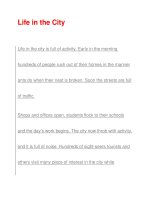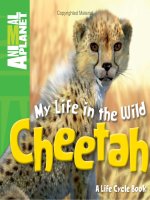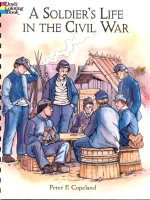life in the wild b
Bạn đang xem bản rút gọn của tài liệu. Xem và tải ngay bản đầy đủ của tài liệu tại đây (40.87 MB, 121 trang )
From the exquisite fragility of a butterfl y to the might and majesty
of a humpback whale, explore the extraordinary diversity of life in
this lavishly illustrated celebration of the animal kingdom. Packed
with awe-inspiring images taken by some of the world’s top wildlife
photographers, here are hundreds of fascinating species in their
natural environments.
Discover more at
www.dk.com
An Incredible Photographic
Portrait of the Animal World
118-119_birds_sandpiper.indd 119 5/5/09 14:29:50US_118-119_birds_sandpiper.indd 119 15/5/09 11:45:52
120-121_birds_gull.indd 120 5/5/09 14:30:38
120
Bi rds
The benign appearance of this
Heermann’s gull (Larus heermanni)
disguises its true character. This
bird is a thief and a bully, snatching
fish from the bill of a brown pelican,
for example, or harassing other
species and forcing them to let go
of their food. Like most gulls, their
wingtips are black. The black
pigment strengthens the feather,
providing protection from the wear
and tear of a gull’s life. Heermann’s
gulls live on the west coast of North
America and Mexico.
US_120-121_birds_gull.indd 120 15/5/09 12:17:15
120-121_birds_gull.indd 121 5/5/09 14:30:57US_120-121_birds_gull.indd 121 15/5/09 12:17:16
122-123_birds_auklet.indd 122 5/5/09 14:34:52
122
bi rds
It is obvious why this bird
is called a rhinoceros auklet
(Cerorhinca monocerata), with
a horn on its bill that can be up to
1 in (25 mm) long. The horn grows
as part of the bird’s breeding
“plumage,” and is molted later
in the year. However, its precise
function is a mystery. The shape
of the bill itself equips the auklet
for a diet of both plankton and fish,
versatility that is denied to some
other auks, which specialize in
either one or the other. Rhinoceros
auklets are found around the
northern Pacific.
US_122-123_birds_auklet.indd 122 15/5/09 12:17:04
122-123_birds_auklet.indd 123 5/5/09 14:35:23US_122-123_birds_auklet.indd 123 15/5/09 12:17:05
124-125_birds_puffin.indd 124 5/5/09 15:41:49
124
bi rds
In its breeding plumage the
tufted puffin (Fratercula cirrhata)
has long, swept back ear-tufts.
In winter, however, it looks quite
different. The ear-tufts and large
greenish “cere” at the base of the
upper mandible are gone and the
white face is dark. The tufted puffin
has an oversized bill, which can be
used to determine the age of the
bird. There are grooves on the bill
that, over the years, become more
obvious and more numerous. One
well-defined groove means the bird
is two to three years old. Two
obvious grooves means the bird
is three or four years old, and
additional grooves signal that
the bird is five or more years old.
US_124-125_birds_puffin.indd 124 15/5/09 12:16:52
124-125_birds_puffin.indd 125 5/5/09 15:42:11US_124-125_birds_puffin.indd 125 15/5/09 12:16:53
126-127_birds_pigeon.indd 126 5/5/09 14:37:18
126
bi rds
With its long neck hackles
and iridescent green feathers,
the Nicobar pigeon (Caloenas
nicobarica) is one of the world’s
best looking pigeons. Its real
curiosity may be less obvious,
however—it has been suggested
that this species is the closest
living relative of the now extinct
dodo. The Nicobar pigeon lives on
small islands off southeast Asia,
Indonesia, and New Guinea but is
unfortunately in decline. Its good
looks may be contributing to its
downfall—many are trapped in
the wild and sold as pets.
US_126-127_birds_pigeon.indd 126 15/5/09 12:16:44
126-127_birds_pigeon.indd 127 5/5/09 14:37:38US_126-127_birds_pigeon.indd 127 15/5/09 12:16:44
128-129_birds_cockatoo.indd 128 5/5/09 14:38:59
Despite its bright colors, the rainbow
lorikeet (Trichoglossus haematodus)
can be surprisingly hard to see
when feeding on nectar, pollen,
and fruit high up in the canopy.
They mate for life and tend to
travel in pairs—although they will
sometimes gather in huge flocks.
US_128-129_birds_cockatoo.indd 128 15/5/09 12:16:36
128-129_birds_cockatoo.indd 129 5/5/09 14:39:22
When alarmed, a palm cockatoo
(Probosciger aterrimus) raises its
crest and its red cheeks become
even redder. It is equipped with a
large, strong bill for breaking into
palm nuts and other similarly tough
nuts and seeds.
US_128-129_birds_cockatoo.indd 129 15/5/09 12:16:36
130-131_birds_owl.indd 130 5/5/09 14:40:11US_130-131_birds_owl.indd 130 15/5/09 12:16:24
130-131_birds_owl.indd 131 5/5/09 14:40:30
The forward-facing eyes of this little
owl (Athene noctua) help it to detect
movement and judge distance.
Owls are unable to move their eyes
in their sockets, but their necks are
highly flexible, allowing them to turn
their heads 270 degrees horizontally
and 90 degrees vertically.
US_130-131_birds_owl.indd 131 15/5/09 12:16:25
132-133_birds_woodnymph.indd 132 5/5/09 14:41:22
132
bi rds
There are more than 300
species of hummingbird in the
world, all found in the Americas
and the Caribbean. Weighing
only
3
⁄20 oz (around 3.9–4.6 g),
this tiny bird is the purple-
crowned woodnymph (Thalurania
colombica). It is plundering the
nectar store of a heliconia in Costa
Rica. Hummingbirds have amazing
aerial abilities—they hover by
flowers, can fly backward, sideways,
and even upside down. The end of
the tongue is split into two channels
that take nectar from the flower by
capillary action, with the tongue
moving in and out between three
and 13 times per second.
US_132-133_birds_woodnymph.indd 132 15/5/09 12:16:17
132-133_birds_woodnymph.indd 133 5/5/09 14:41:56US_132-133_birds_woodnymph.indd 133 15/5/09 12:16:18
134-135_birds_kingfisher.indd 134 5/5/09 14:43:24
134
Bi rds
The African malachite kingfisher
(Alcedo cristata) is very similar
to the kingfisher of Europe. This
sparkling blue and orange bird
watches the water carefully from
its perch. Like the bald eagle, it
has two foveae (the point at which
an image is at the sharpest focus)
per eye, one pointing to the side
and one pointing forward. When the
bird spots movement to the side it
moves its head so that the potential
prey is focused in its forward-
pointing foveae, where its position
can be pinpointed. There is a
lightning-quick dive, and then,
usually, the kingfisher is back on
its perch with a fish in its bill.
US_134-135_birds_kingfisher.indd 134 1/6/09 12:49:10
134-135_birds_kingfisher.indd 135 5/5/09 14:43:42US_134-135_birds_kingfisher.indd 135 15/5/09 12:16:11
136-137_birds_roller.indd 136 5/5/09 14:44:27
136
bi rds
The gorgeously colored lilac-
breasted roller (Coracias caudatus)
is usually seen perched at a high
vantage point, such as the top of
a tree or a pole, from where it can
easily spot its next meal on the
ground, be it a beetle, grasshopper,
snail, scorpion, or even a small
mammal or bird. The lilac-breasted
roller is common in much of sub-
Saharan Africa, where it makes the
most of bush fires, seizing small
creatures as they flee the flames.
US_136-137_birds_roller.indd 136 15/5/09 12:16:03
136-137_birds_roller.indd 137 5/5/09 14:44:48US_136-137_birds_roller.indd 137 15/5/09 12:16:03
138-139_birds_hornbill.indd 138 5/5/09 14:49:04US_138-139_birds_hornbill.indd 138 15/5/09 12:15:56
138-139_birds_hornbill.indd 139 5/5/09 14:49:26
139
Bi rds
o
The most remarkable feature of
the great Indian hornbill (Buceros
bicornis) is the huge enlargement,
known as a “casque,” on top of its
already very sizable bill. The
function of the hollow casque is
uncertain: the bird may use it to
knock fruit out of trees, or it may
play some kind of territorial
role—very rarely, two males have
been seen “casque-clashing.” The
feathers around this bird’s face
are not naturally yellow; the color
comes from the hornbill’s preen oil,
which it uses to keep its plumage
in good condition.
US_138-139_birds_hornbill.indd 139 15/5/09 12:15:56
140-141_birds_toucan.indd 140 5/5/09 15:43:07US_140-141_birds_toucan.indd 140 15/5/09 12:15:43
140-141_birds_toucan.indd 141 5/5/09 15:43:34
141
bi rds
The keel-billed toucan
(Ramphastos sulfuratus) of
South America is also known
as the rainbow-billed toucan and
the sulfur-breasted toucan. It has
a long, lightweight, colorful bill that
provides the bird with a number
of advantages. Its bill enables the
toucan to reach fruits borne on
parts of a tree that could not take
its weight, and is used in threat
displays against other fruit-eating
birds. As well as fruit, the toucan
also eats insects, lizards, and tree
frogs, and will even take the eggs
and fledglings of smaller birds,
using its bill to frighten the parent
birds away from their nest.
US_140-141_birds_toucan.indd 141 15/5/09 12:15:44
142-143_birds_sunbird.indd 142 5/5/09 14:45:38
142
bi rds
Sunbirds of the Nectariniidae
family are the Old World equivalent
of the hummingbirds of the
Americas, but they are not closely
related. This beautiful sunbird is
feeding at flowers in Rwanda.
Most male sunbirds have iridescent
feathers, and, like hummingbirds,
a bill and tongue that can collect
nectar, though they normally perch
rather than hover when feeding.
Many sunbirds also eat spiders and
other small invertebrates, which are
picked off flowers and foliage, or
taken in mid-air.
US_142-143_birds_sunbird.indd 142 15/5/09 12:15:36









